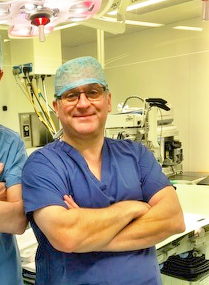Looking after your feet and ankles: Focus on sprains and fractures
Leading foot and ankle surgeon, Mr Lloyd Williams, provides advice on the importance of looking after your feet and ankles and what treatment is available to you if you’re unlucky enough to sustain an ankle injury.

Lloyd Williams, MB BS FRCS (Tr&Orth)
Mr R. Lloyd Williams is a Consultant Orthopaedic Surgeon Specialising in Foot and Ankle Disorders.
“Be careful during the winter when it can be slippery, wet or icy underfoot. Foot and ankle injuries account for over 20% of Emergency Department attendances. My advice is to tread carefully!”
Sprains and fractures are the two most common serious ankle and foot injuries:
- Sprains: These occur when the ligaments that support the ankle are stretched or torn. They can happen from slips, trips, or falls on wet, icy, or snow-covered ground.
- Fractures: Bones in the foot and ankle can be broken from a fall or twisting the ankle on a slippery surface.
These common injuries can be prevented by taking precautions such as such as wearing practical and supportive footwear, and being more careful when walking on slippery, icy or wet surfaces.

QUESTION: Can you give our audience some advice in relation to a sprained ankle?
Mr Williams: “In my professional practice, I see patients with ankle trouble which often begins following an ankle sprain, a very common injury. Classically, patients twist or invert their ankle, causing injury to the lateral ligaments found on the outside of the ankle.”
Thankfully, most ankle sprains are not too serious, and they heal uneventfully. Mr Williams says, “Most ankle sprains can be managed with simple measures including protected weight-bearing with crutches, rest, ice, elevation, and compression bandaging. Physiotherapy is also important to improve fine ankle control and balance. Most people should be feeling confident again within 6 to 12 weeks.”
Long-term pain in the foot following a sprain is another symptom that should not be ignored. Ankle impingement occurs when the ruptured ankle ligament heals with lots of thickening, sometimes folding in and getting pinched in the joint. An ultrasound-guided steroid injection into the painful area can settle the symptoms. However, for persistent impingement symptoms, an ankle arthroscopy may be necessary. Deep ankle pain following a sprain is worrying and may indicate damage to the specialised cartilage inside the ankle joint. “At the time of the ankle sprain, the specialised articular cartilage that lines the joints can be damaged. Arthroscopic surgery is a powerful tool I can use, where necessary, to perform microfracture – a process where the bone marrow is stimulated to form new cartilage.”

QUESTION: A sprain or a fracture? How to tell, and when to seek further advice?
Mr Williams: Not everyone, however, gets away with a simple quick-healing sprain. People should know when to seek advice to rule out a more serious injury, such as a fracture. Mr Williams points out, “If patients have severe pain, are unable to weight-bear after the injury, or have bony tenderness, it is quite possible that there is a more complicated injury rather than just an ankle sprain. For such patients, I would recommend an X-ray to rule out a fracture.”
There can be longer-term problems too. “In up to 20% of cases, patients can develop long-term instability and recurrent giving-way of the ankle. In my hands, if conservative measures have failed, surgical reconstruction of the lateral ligaments is necessary, which is known as a Brostrom-Gould procedure. This is a particularly reliable operation, with 95% of patients regaining stability and trust in their ankle, allowing a return to sport.”
Get in contact with Mr Lloyd Williams
Mr Williams practices from the London Orthopaedic Clinic which is based at OneWelbeck Hospital in Marylebone.
28 March: Free talk by Mr Lloyd Williams at Lloyd’s
Reserve your place at Mr Williams’ live in-person, free lunchtime talk in the Lloyd’s Building on 28th March 2023 at 1:00 pm.
Book a free 10-minute ‘Mini Consultation’ with Mr Lloyd Williams
Limited one-to-one “mini consultations” with Mr Williams. There are limited slots scheduled for the afternoons of 28th March and 4th April 2023.







